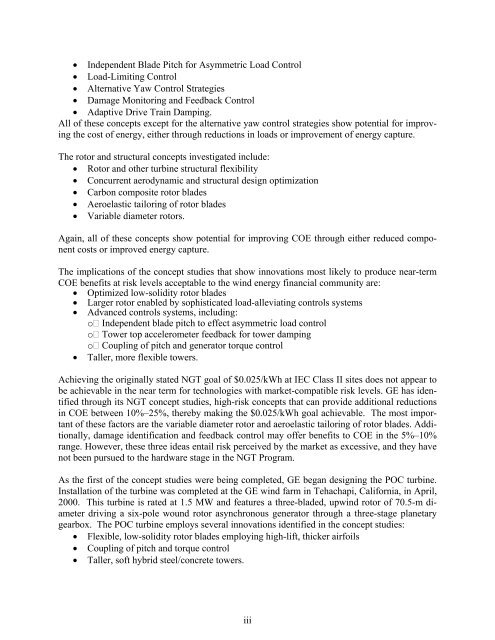Advanced Wind Turbine Program Next Generation Turbine ... - NREL
Advanced Wind Turbine Program Next Generation Turbine ... - NREL
Advanced Wind Turbine Program Next Generation Turbine ... - NREL
Create successful ePaper yourself
Turn your PDF publications into a flip-book with our unique Google optimized e-Paper software.
• Independent Blade Pitch for Asymmetric Load Control<br />
• Load-Limiting Control<br />
• Alternative Yaw Control Strategies<br />
• Damage Monitoring and Feedback Control<br />
• Adaptive Drive Train Damping.<br />
All of these concepts except for the alternative yaw control strategies show potential for improving<br />
the cost of energy, either through reductions in loads or improvement of energy capture.<br />
The rotor and structural concepts investigated include:<br />
• Rotor and other turbine structural flexibility<br />
• Concurrent aerodynamic and structural design optimization<br />
• Carbon composite rotor blades<br />
• Aeroelastic tailoring of rotor blades<br />
• Variable diameter rotors.<br />
Again, all of these concepts show potential for improving COE through either reduced component<br />
costs or improved energy capture.<br />
The implications of the concept studies that show innovations most likely to produce near-term<br />
COE benefits at risk levels acceptable to the wind energy financial community are:<br />
• Optimized low-solidity rotor blades<br />
• Larger rotor enabled by sophisticated load-alleviating controls systems<br />
• <strong>Advanced</strong> controls systems, including:<br />
o Independent blade pitch to effect asymmetric load control<br />
o Tower top accelerometer feedback for tower damping<br />
o Coupling of pitch and generator torque control<br />
• Taller, more flexible towers.<br />
Achieving the originally stated NGT goal of $0.025/kWh at IEC Class II sites does not appear to<br />
be achievable in the near term for technologies with market-compatible risk levels. GE has identified<br />
through its NGT concept studies, high-risk concepts that can provide additional reductions<br />
in COE between 10%–25%, thereby making the $0.025/kWh goal achievable. The most important<br />
of these factors are the variable diameter rotor and aeroelastic tailoring of rotor blades. Additionally,<br />
damage identification and feedback control may offer benefits to COE in the 5%–10%<br />
range. However, these three ideas entail risk perceived by the market as excessive, and they have<br />
not been pursued to the hardware stage in the NGT <strong>Program</strong>.<br />
As the first of the concept studies were being completed, GE began designing the POC turbine.<br />
Installation of the turbine was completed at the GE wind farm in Tehachapi, California, in April,<br />
2000. This turbine is rated at 1.5 MW and features a three-bladed, upwind rotor of 70.5-m diameter<br />
driving a six-pole wound rotor asynchronous generator through a three-stage planetary<br />
gearbox. The POC turbine employs several innovations identified in the concept studies:<br />
• Flexible, low-solidity rotor blades employing high-lift, thicker airfoils<br />
• Coupling of pitch and torque control<br />
• Taller, soft hybrid steel/concrete towers.<br />
iii
















